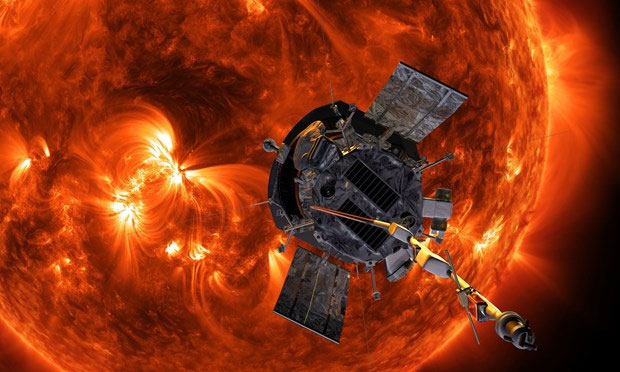Reveal surprising findings related to solar wind and magnetic storms
The data sent by the Parker Solar probe will provide new details about the solar wind, magnetic storms and how the Sun is creating weather in the universe.
Scientists will first gain insights into the solar wind and magnetic storms that could negatively impact satellites and electronics on Earth after the Parker Solar probe. closer to the Sun's surface and send in data regarding the Sun's halo, a superheated region in the atmosphere.
According to research published on December 4 in the journal Nature, the Parker Solar spacecraft of the US Aerospace Agency (NASA), the size of a car and was launched into space in August last year. , have made the closest journey to the Sun so far and will try to reach the point just 6 million km from the sun on test flights conducted over the next 7 years.
The data that Parker Solar sends will provide new details about the solar wind, magnetic storms and how the sun creates weather in the universe.

The Parker Solar probe is closer to the sun's surface.(Source: NASA).
However, the main concern currently associated with the polls is temperatures of up to 1 million degrees Celsius in the Sun's corona , many times higher than the temperature on the sun's surface itself, which is only 6,000 degrees Celsius.
So, according to scientist Alexis Rouillard of the French National Center for Scientific Research (CNRS) and co-author of one of the four papers related to the first findings of the Parker Solar probe, the The researchers will have to figure out how the Sun's halo is able to heat itself up, rather than having to cool down according to the conventional principle (the further away from a heat source, the lower the temperature).
Sharing this view, professor of aerospace science and engineer Justin Kasper also said that as soon as Parker Solar first approached the outer orbits of the Sun, the team was shocked about the temperature change of the solar halo .
A previous University of Michigan study suggested that fluctuations in the Sun's magnetic field could be a factor in the warming of the Sun.
However, the new data show that magnetic waves are in fact much stronger, so strong that they can completely turn the direction of the magnetic field and generate energy for the Sun's halo.
Also in the new study of Parker Solar, scientists were surprised to discover the principle of acceleration of the solar wind and the orbits of protons, electrons and other particles emitted from the Sun.
Previously, science had thought that the closer it gets, the Sun's magnetic field will suck the wind in the same direction it moves and the effect will weaken as it gets farther away.
However, when the Parker Solar probe came closer to the Sun, they discovered revolutions 10-20 times larger than the models they predicted.
This new discovery has completely changed the hypothesis so far about how solar wind is created.
A better understanding of this will help scientists make more accurate predictions about the weather in the universe, especially in determining how the Sun will affect the Earth and prepare for the human journey to the moon and Mars.
In 1859, a "cosmic weather event" paralyzed the telegraph network on Earth.
According to physics professor Stuart Bale of the University of California Berkeley, as society increasingly relies on advanced technology, the impact from the Sun can become very serious. If space weather could be promptly forecasted, humans could completely shut down or isolate a part of the grid, or turn off vulnerable satellite systems.
The Earth is 150 million km from the Sun and the Parker Solar probe has reached a point only 24 million km from the Sun to collect data for research purposes. The ultimate goal is that the ship can reach the point just 6 million km from the surface of the Sun, 7 times closer than any previous spacecraft.
The Parker Solar can withstand the intense heat of flying through the sun halo, the outermost area and also the place to create the solar wind from the combination of extremely hot charged particles emanating from the sun.
The Parker Solar probe, named after the American astrophysicist Eugene Parker, was the first to propose the theory of the solar wind when describing it as a magnetic system, solar particles. amount and plasma form.
- The NASA probe set a record to reach the nearest Sun
- NASA spent $ 1.5 billion to send a spacecraft to the Sun
- Dozens of strong storms and storms can pour into Vietnam
- Magnetic storms can ruin the 2012 Olympics
- What is solar storm?
- Ancient texts help forecast ... the solar storm
- What mysterious forces have prevented the Sun storms?
- Magnetic storm has just attacked the earth
- The solar field is about to turn extreme
- 40 amazing, unexpected facts about the sun that you don't know (P2)
- The Sun Storm caused many animals to get lost?
- Specialists warning of extreme catastrophes from Earth may be about to turn around
- Solar storm attacks the earth
- Storm from high in 2011
 Van Allen's belt and evidence that the Apollo 11 mission to the Moon was myth
Van Allen's belt and evidence that the Apollo 11 mission to the Moon was myth The levels of civilization in the universe (Kardashev scale)
The levels of civilization in the universe (Kardashev scale) Today Mars, the sun and the Earth are aligned
Today Mars, the sun and the Earth are aligned The Amazon owner announced a secret plan to build a space base for thousands of people
The Amazon owner announced a secret plan to build a space base for thousands of people